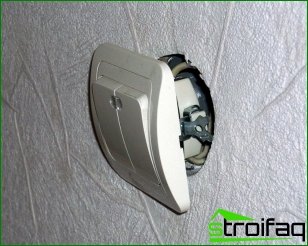Most often, when a breaker fails, it is simply replaced. Why? Everything is very simple – this is a relatively inexpensive part, the purchase of which does not take so much money. therefore do-it-yourself circuit breaker repair It’s not so difficult to pay for expensive specialist services.
The usual replacement of a broken device will take very little time. If it is necessary not only to install a switch, but also to take care of wiring a new circuit, then much more time will be required. From the very beginning it is important to determine the height of the switch and the type of wiring.
Choose a suitable height
Neither power nor any other lighting characteristics depend on the choice of installation height: everything here is determined by the ease of use and the preferences of the owners. Not so long ago, the standard for installing devices was considered height at eye level, but recently it has won the location of switches at a height of a meter from the floor. Now you do not even need to raise your hand to turn on or off the lighting. The location of the device is also not important – the main thing is that it is convenient for the owners to use it.
Most often, when a breaker fails, it is simply replaced. Why? Everything is very simple – this is a relatively inexpensive part, the purchase of which does not take so much money. therefore do-it-yourself circuit breaker repair It’s not so difficult to pay for expensive specialist services.
The usual replacement of a broken device will take very little time. If it is necessary not only to install a switch, but also to take care of wiring a new circuit, then much more time will be required. From the very beginning it is important to determine the height of the switch and the type of wiring.
Choose a suitable height
Neither power nor any other lighting characteristics depend on the choice of installation height: everything here is determined by the ease of use and the preferences of the owners. Not so long ago, the standard for installing devices was considered height at eye level, but recently it has won the location of switches at a height of a meter from the floor. Now you do not even need to raise your hand to turn on or off the lighting. The location of the device is also not important – the main thing is that it is convenient for the owners to use it.
Built-in and outdoor switches
Wiring is closed and open. Open – this is one that is laid on the surface (often it is placed in a special box), and the closed one is under a layer of plaster. Switches in this way can be built-in or outdoor. The embedded ones are placed in a box that is walled into the wall, while the external ones are simply mounted on the wall surface.
Do-it-yourself circuit breaker repair: instrument installation
With hidden wiring, the installation of the switch begins with the installation of the box. To begin, unscrew the screws from it, after which it is necessary to carefully break off the plug of the wiring hole. As a rule, there are five such holes in a box: there are four on each side and one in the bottom. Their choice depends on which side the electric wire is suitable for..
Now the box needs to be installed. To begin, insert it into the slotted niche, check – it should fit freely in it. After that, prepare a solution of building alabaster (the thickness of the putty should resemble sour cream). Using a narrow spatula, apply a small amount of putty to the niche, and also apply a small amount of putty directly to the box, then insert it into the niche. The edge of the box with the wall should be one plane. If the alabaster mixture was not enough, you can always add it. Remember that you are not expected to fill all the gaps between the wall and the box: all you need is just to lock the box in the required position.
Work must be done without excessive haste, but it should not be delayed either: the alabaster hardens rather quickly. Remember that alabaster should not get into the broken window through which the wire is inserted. If this happened, then until the alabaster has frozen, you need to collect its surplus.
Now we wait until the mixture hardens. At this time, you can prepare the wire – strip its ends from insulation. Then you need to insert it into the hole in the box. The free end of the wire should be no more than ten centimeters, otherwise it simply will not allow the switch to fit in the box. On the other hand, too short a wire will lead to inconvenience.
Circuit Breaker Preparation
Now you need to knead the gypsum putty and fill the remaining space between the niche and the box. Now the box is installed, we return to the switch. Before installing it, the switch must be disassembled. Most often, for this you need to remove the key or keys (if there are two or three). Usually this is done with a screwdriver, then remove the latch that holds the top plate. After it is removed, we disassemble the switch itself with a screwdriver.
The wires must be connected to the switch: loosen the terminal screws, insert the stripped ends of the wiring and tighten the terminals. The switch is secured in the box due to the spread of special screws or levers. We install the switch in the box, while it is important to pay attention to the location of the contacts: when turned off, they should turn down, and when turned on, turn up. Now it can be fixed with screws. With the help of screws, we extend the spacer levers until the switch is securely locked. If you plan to stick the wallpaper, then you should not close the switch with a lid and install keys on it – this can be done even after pasting.
As seen do-it-yourself circuit breaker repair does not represent something overly complex. All that is needed is accuracy and attentiveness. Thanks to them, you can save a lot on electrician services.







